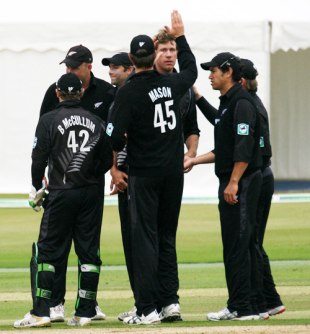It's been lauded as a great turnaround, New Zealand winning the ODI series against England, but I'd argue it was nothing more than could be expected.
Off the back of a 0-2 Test series loss New Zealand were soundly beaten in the
Twenty20 fixture and then in the
first ODI. All of a sudden they were being described as some sort of devastated rabble lacking in the skills of the game. But New Zealand have been losing Test matches from winning positions for the last six years, so nothing new there. And for no good reason they are not the strength they perhaps should be in Twenty20. One-day cricket is their forte, without doubt, so when they followed up their prior poor results in this tour with a loss in game one of the ODI series, everyone immediately pushed the panic button... myself included. However, looking at that game objectively, one of cricket's most talented and destructive players, Kevin Pietersen, played a blinder - and in ODIs one man's batting display can often decide a match. Sure, New Zealand lost by 114 runs but when one team makes over 300, a batting collapse is always on the cards in the second innings as caution is thrown to the wind.
I doubt that result destroyed New Zealand's belief, but as far as getting things falling their way again went, they probably needed a catalyst. That came in
game two from an unlikely source. Well, two sources actually. The rain and England's captain, Paul Collingwood. In a shortened game, defending an inadequate total, Collingwood went on a go-slow, hoping the weather would save him. It did, by one over. Nineteen overs into New Zealand's reply and right on target for a Duckworth-Lewis victory at the 20-overs mark, rain halted play for good. It was a no-result that left New Zealand feeling cheated. I know personally that there are some nasty characters in this New Zealand side and when they get their backs up, it brings the best out of them rather than a loss of control.
Anger was effectively channelled into determination in
game three and when you find yourselves six down for 75, you need a bit of determination. It was grit-your-teeth stuff that saw New Zealand through to a defendable 182. I say "defendable" because of the conditions that prevailed that day in Bristol. I've always believed New Zealand sides play best when they have their backs up, and also when they're up against the wall, but I also believe New Zealand performs comparatively better in bowler-friendly conditions. In defending 182, this side did what could be expected.
Once you let the better side back into a contest, that side is invariably the victor. Good sides absorb pressure, ride it out, turn it round, and when given the opening, heap it back on tenfold. Better sides also seem to prevail in the close games because they have belief and that belief ensures heads remain comparatively clear.
Game four was close all right, New Zealand winning from the last ball with only one wicket in hand. You could also argue that heads were not clear but rather clouded with rage following another Collingwood misdemeanour, when he failed to recall New Zealand's Grant Elliot after he was run out in the aftermath of a mid-pitch collision with bowler Ryan Sidebottom during an attempt at a quick single.
The subtext from this game read all wrong for England. New Zealand now had a key man back in form in Scott Styris; Jacob Oram was back from injury and had some runs under his belt; a young fast bowler, Tim Southee, had announced himself to the world; and there was renewed belief and a lust for revenge against an England team they perceived as doing them wrong. England on the other hand looked a rabble, were apologetic, and now were without their captain, who had been suspended for the slow over-rate of game four.
So it was no real surprise then that in
game five New Zealand pulled off a display of controlled domination. Their 51-run victory at Lord's was as good a display of ODI cricket as you are likely to see. Having lost the toss they were put in in conditions that were offering just a little. They quickly summed up the situation, developed a strategy that would have cautioned conservatism against England's quality frontline seamers, and an exploitation of England's weaker fourth, fifth and sixth options, knowing that the best chance for piling on the runs would come in the last ten overs. If that was the plan, they effected it perfectly. Even Brendan McCullum was circumspect at the top, and Styris was outstanding at the death. England had no answer and crumbled.
Perhaps this New Zealand team arrived at the appropriate series result in a slightly covert fashion, given their ICC ODI ranking of No. 3, but under closer inspection they dominated key moments and made them match-winning moments. Rather like what the superior England did in the Test matches. As far as I'm concerned, what we got was normal transmission.
